AMD FX-8370E CPU Review: Vishera Down to 95W, Price Cuts for FX
by Ian Cutress on September 2, 2014 8:00 AM ESTCPU Benchmarks
The dynamics of CPU Turbo modes, with both Intel and AMD, can cause concern during environments with a variable threaded workload. There is also an added issue of the motherboard remaining consistent, depending on how the motherboard manufacturer wants to add in their own boosting technologies over the ones that Intel would prefer they used. In order to remain consistent, we implement an OS-level unique high performance mode on all the CPUs we test which should override any motherboard manufacturer performance mode.
HandBrake v0.9.9: link
For HandBrake, we take two videos (a 2h20 640x266 DVD rip and a 10min double UHD 3840x4320 animation short) and convert them to x264 format in an MP4 container. Results are given in terms of the frames per second processed, and HandBrake uses as many threads as possible.
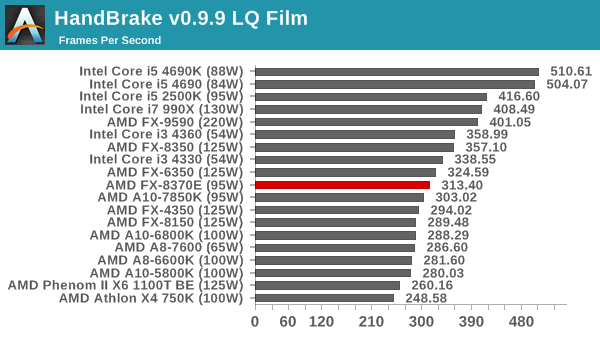
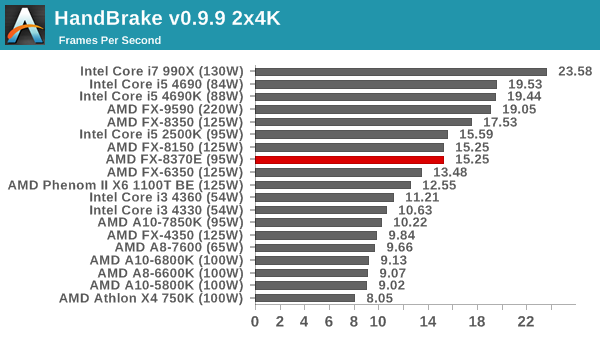
Handbrake balances cores and frequency, with the LQ film test often condensing CPUs based on frequency and the double UHD test expanding by cores. The double UHD test puts the 8370E at the bottom of the AMD 8-thread CPUs as expected.
Agisoft Photoscan – 2D to 3D Image Manipulation: link
Agisoft Photoscan creates 3D models from 2D images, a process which is very computationally expensive. The algorithm is split into four distinct phases, and different phases of the model reconstruction require either fast memory, fast IPC, more cores, or even OpenCL compute devices to hand. Agisoft supplied us with a special version of the software to script the process, where we take 50 images of a stately home and convert it into a medium quality model. This benchmark typically takes around 15-20 minutes on a high end PC on the CPU alone, with GPUs reducing the time.
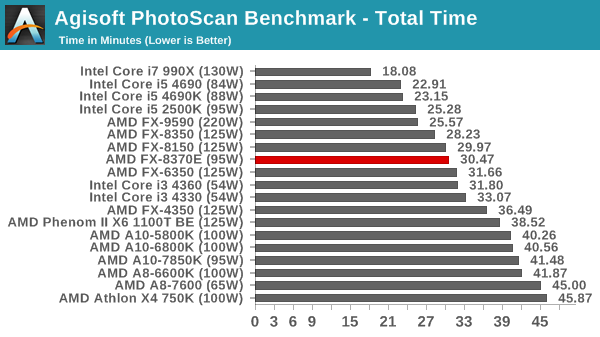
Photoscan results seem to take the following order: i7, i5, FX (8), FX (6), i3, FX (4), A10, A8. The 8370E sits at the bottom of the FX 8-thread section as before.
WinRAR 5.0.1: link

WinRAR takes advantage of all the AMD threads due to its integer workloads.
PCMark8 v2 OpenCL
A new addition to our CPU testing suite is PCMark8 v2, where we test the Work 2.0 and Creative 3.0 suites in OpenCL mode. As this test is new, we have not run it on many AMD systems yet and will do so as soon as we can.

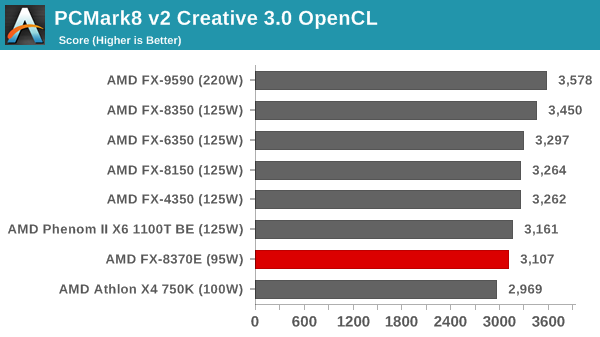
The PCMark8 tests both seem to favor frequency at this point, with the FX-9590 taking the lead.
Hybrid x265
Hybrid is a new benchmark, where we take a 4K 1500 frame video and convert it into an x265 format without audio. Results are given in frames per second.
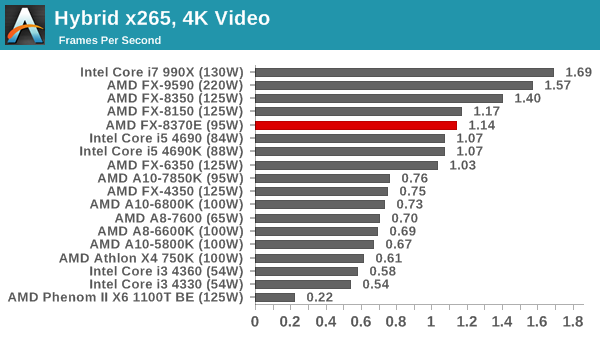
Again, more threads gives an intesting workload. The FX-8370E beats out the i5-4690K as well.
Cinebench R15
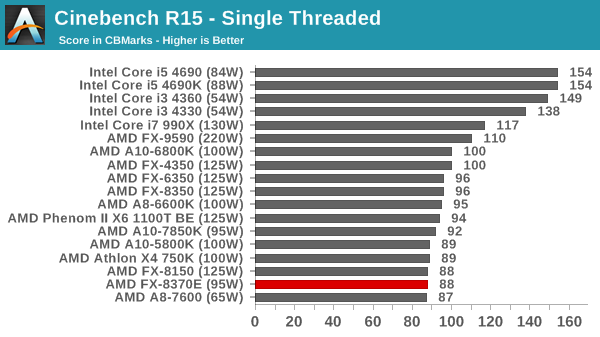

Unfortunately the Achilles heel strikes again in single threaded performance. Multithreaded puts it just behind the FX-8150.
3D Particle Movement
3DPM is a self-penned benchmark, taking basic 3D movement algorithms used in Brownian Motion simulations and testing them for speed. High floating point performance, MHz and IPC wins in the single thread version, whereas the multithread version has to handle the threads and loves more cores.

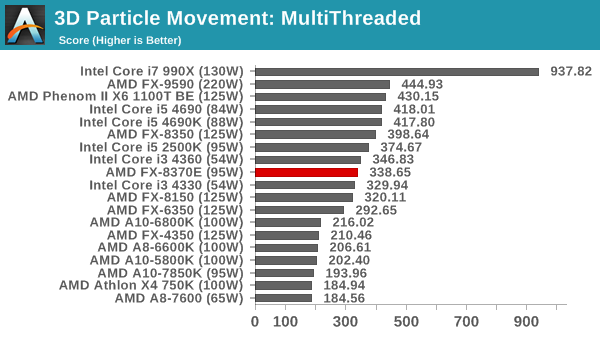
FastStone Image Viewer 4.9
FastStone is the program I use to perform quick or bulk actions on images, such as resizing, adjusting for color and cropping. In our test we take a series of 170 images in various sizes and formats and convert them all into 640x480 .gif files, maintaining the aspect ratio. FastStone does not use multithreading for this test, and results are given in seconds.
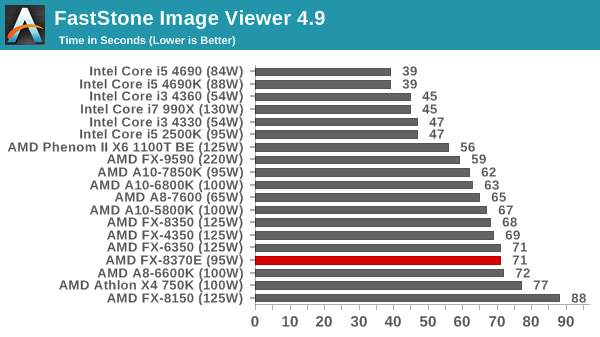
Web Benchmarks
On the lower end processors, general usability is a big factor of experience, especially as we move into the HTML5 era of web browsing. For our web benchmarks, we take four well known tests with Chrome 35 as a consistent browser.
Sunspider 1.0.2
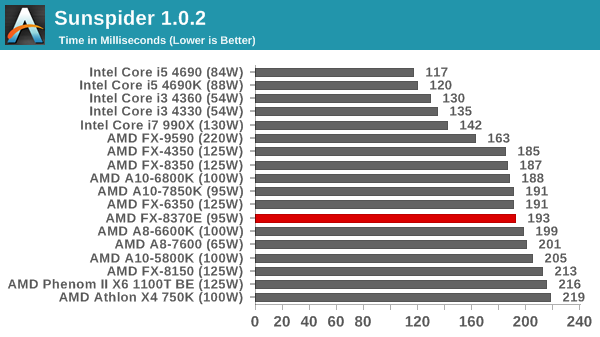
Mozilla Kraken 1.1
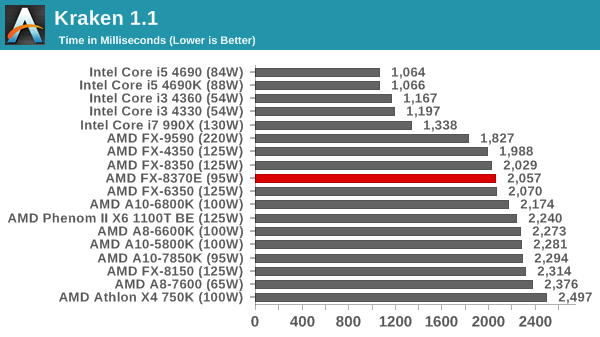
WebXPRT
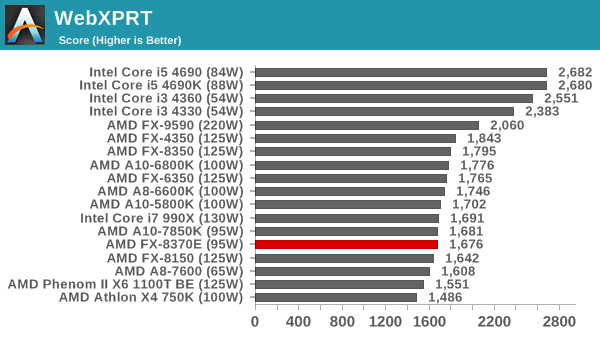
Google Octane v2
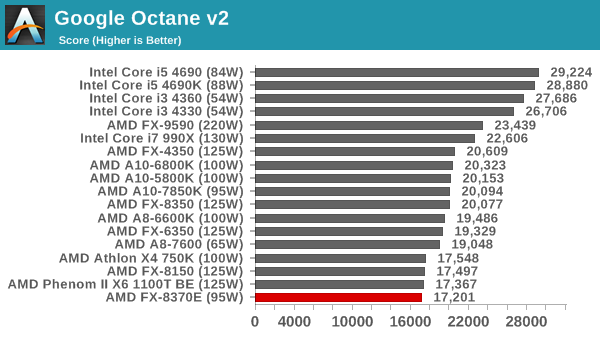










107 Comments
View All Comments
Kjella - Tuesday, September 2, 2014 - link
"Personally, I'd much rather see AMD make a comprehensive and honest effort to open up about their future products and roadmaps"AMD has been fairly clear on where they're going in their investor briefs, but it's probably not what you want to hear. They're executing a "transformation strategy" to get 50% of their revenue from the "Enterprise, Embedded and Semi-Custom segment" as opposed to the "Computing and Graphics segment" which is the traditional AMD/ATI business.
Where do you think this funding comes from? The CPU/APU/GPU research and development they're not doing, like a FX successor. And with that no new chipset, no new socket, no new motherboard validation. If you haven't noticed, they've been on a skeleton crew for some time now. All they're hyping is HSA which is semi-custom tech because normal apps have to serve the 80%+ not running AMD APUs.
For us, the mass market consumers of retail CPUs and GPUs I can give you a pretty accurate but grim forecast, AMD will continue to dodge direct competition. They can't compete with Intel on performance or power efficiency and with Intel so far ahead in processing technology they can't afford to undercut them on price either. Whatever their dual ARM/x86 processor ends up being, I'm pretty sure it's not primarily for us regular consumers.
haukionkannel - Tuesday, September 2, 2014 - link
Did you read the ansver from AMD about future FX prosessors. It seems that power efficiency is the way they are going next. Guite sensible because FX prosessor are fast enough all normal people, and they have no chance against Intel in the high end. They just not have enough money to compete properly.Maybe we see in the future a little bit faster Jaguar mini cores in FX line and normal Jaguar editions in mainstream APU machines. In that segment they have some possibilities to fight ARM and Intel processors.
Spoony - Tuesday, September 2, 2014 - link
I so much want to be able to shop between Intel and AMD when I purchase a CPU. Make it happen for me, AMD!zmeul - Tuesday, September 2, 2014 - link
when your FX CPU performs worse than an i3 CPU (in quite a lot of tests), it's time to change or get out of the businessKevin G - Tuesday, September 2, 2014 - link
This is a case of AMD kicking the can down the road. This release is meant to keep socket AM3+ limping along for a little while longer. Without a design refresh (Steamroller) and a new chipset, there hasn't been a reason to recommend the socket AM3+ platform for over year. Sure, it is nice that current owners have an upgrade path to faster parts. Considering the time it has taken to get these faster or more energy efficient parts to market one has to question if the wait has been worth it? Especially when compared to the evolving platforms on the Intel side.landerf - Tuesday, September 2, 2014 - link
Jesus those charts were brutaltexasti89 - Tuesday, September 2, 2014 - link
I don't see any substantial improvement in the per/watt ratio for these new SKUs. The performance data still look dismal against Intel's low end chips. As much as I want AMD to compete on the intended space for these chips, but these Bulldozer-based cups are truly pathetic. I'm really fed with these CPUs coming out in reviews for year by now.Germanicus - Tuesday, September 2, 2014 - link
So the comments, as predicted, are full of AMD-bashing. But lets think about his a second: do you really expect a company with 1/10th the resources of Intel to even come close to match it in performance and efficiency? Not only that, but AMD has multiple product types to juggle it's resources on (CPU/GPU/APU) whereas Intel has only a single focus.Not only that, but at least when buying AMD you don't get that dirty feeling you experience when you buy from a company like Intel, with it's lengthy history of anti-competitive business practices.
AMD is working on a new architecture, but it takes time. Patience, grasshopper!
mrdude - Tuesday, September 2, 2014 - link
Oh, are they? What TDP? What platform? Desktop/notebook/server? All 3? Socket? Target market segment? What about performance? Will it be better performing or equivalent but lower power? Neither? Does the x86 version outperform the ARM? Or is it vice versa? Is it going to be the same general architecture or are we talking two completely different architectures with different features? SoC or chipset? SoC + chipset? Is it BGA only or are we going to be able to buy socketed versions? Is AMD even going to release another chip for DIY'ers and enthusiasts post-Carrizo at all?All of the those are unanswered. Every single one. Think about that for a second and digest it. You're asking for patience when there isn't even a general direction or roadmap. So patient for what exactly?
The comments above aren't AMD bashing, but rather product bashing. AMD hasn't been competitive for a long while now and rehashing the same wasn't-competitive-even-then product doesn't help matters any.
So don't mistake peoples' frustrations with AMD as AMD-hating or AMD-bashing, but AMD-disappointment. There's a huge portion of the population that wants to buy an AMD CPU/APU but has been waiting since the Bulldozer debacle to find something even remotely interesting -- and I'm most certainly in that camp.
Germanicus - Tuesday, September 2, 2014 - link
They've already answered some of your questions, but I'm not going to Google for you.